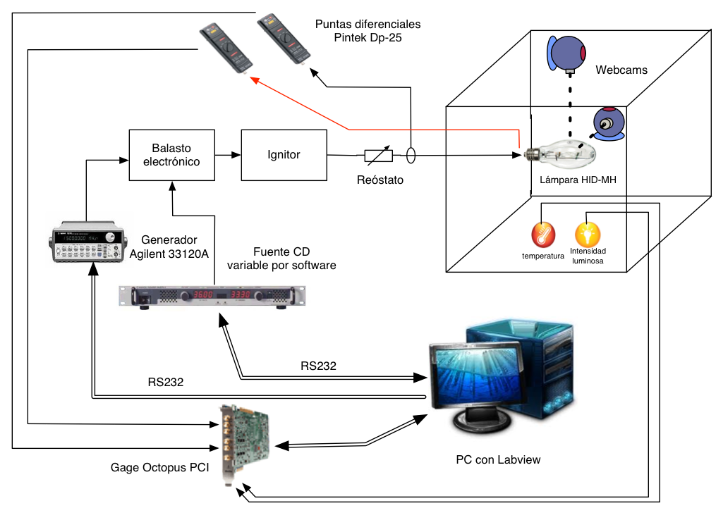Dynamic behavior of HID-MH lamps when operating at high frequency with a square wave
Main Article Content
Abstract
The dynamic operating characteristics of the equivalent impedance of metal halide lamps, when fed with a high-frequency square wave (10 kHz to 50 kHz), are investigated. Electrical variables such as voltage, current, and power, as well as physical variables such as temperature and luminous intensity, are analyzed in their behavior against variations in the frequency of operation. In addition, a method that allows quantifying the amplitude of the longitudinal acoustic resonance in each frequency of operation of the HID-MH lamps is proposed.
Downloads
Article Details

This work is licensed under a Creative Commons Attribution 4.0 International License.
Authors who publish in this journal agree to the following terms: Authors retain the copyright and guarantee the journal the right to be the first publication of the work, as well as, licensed under a Creative Commons Attribution License that allows others share the work with an acknowledgment of the authorship of the work and the initial publication in this journal. Authors may separately establish additional agreements for the non-exclusive distribution of the version of the work published in the journal (for example, placing it in an institutional repository or publishing it in a book), with acknowledgment of its initial publication in this journal. Authors are allowed and encouraged to disseminate their work electronically (for example, in institutional repositories or on their own website) before and during the submission process, as it may lead to productive exchanges as well as further citation earliest and oldest of published works.
How to Cite
References
[2] H. Nishimura, H. Nagase, K. Uchihashi, T. Shiomi, and M. Fukuhara, “A new electronic ballasts for hid lamps,” J. Illum. Eng. Soc., vol. 17, no. 2, pp. 70–76, 1988.
[3] L. Hua, S. Miaosen, J. Yifeng, and Q. Zhaoming, “A novel low- frequency electronic ballast for hid lamps,” Industry Applications, IEEE Transactions, vol. 41, no. 5, pp. 1401–1408, 2005.
[4] G. Lister, “The physics of discharge lamps,” vol. 76, 2004.
[5] W. Kaiser, R. Marques, and A. Correa, “An alternative optical method for acoustic resonance detection in hid lamps,” in Industry Applications
Society Annual Meeting (IAS), 2011, pp. 1–5.
[6] Y. Wang, D. Xu, W. Wang, X. Zhang, and B. Xu, “Electronic ballast for
metal halide lamps using a quasi-resonant inverter with digital control,” Industrial Electronics, IEEE Transactions, vol. 59, no. 4, pp. 1825–1840, 2012.
[7] Television-Composite Analog Video Signal-NTSC for Studio Applica- tions. SMPTE-170M, 1994.
[8] M. Costa, J. Alonso, J. Garcia, J. Cardesin, and M. Rico Secades, “Acoustic resonance characterization of low-wattage metal-halide lamps under low-frequency square-waveform operation,” in Power Electronics, IEEE Transactions, vol. 22, 2007, pp. 735–743.
[9] M. Dalla Costa, “Compensación de resonancias acústicas en lámparas de descarga en halogenuros metálicos por medio de onda cuadrada de baja frecuencia: Caracterización de lámparas y propuesta de nuevas topologías de alimentación,” Ph.D. dissertation, 2008.
[10] D. Van Casteren, M. Hendrix, and J. Duarte, “Controlled hid lamp- ballast interaction for low-frequency square-wave drivers,” Power Elec- tronics, IEEE Transactions, vol. 22, no. 3, pp. 780–788, 2007.
[11] J. Vila Masot and O. Melis, Low frequency square wave electronic ballasts for gas discharge. USA: Patent US 5428268 A, 1995.
[12] C. Hung Liang, M. Chin Sien, Y. Chung Sheng, and H. Chun Kai, “Analysis and implementation of an hpf electronic ballast for hid lamps with lfsw voltage,” Power Electronics, IEEE Transactions, vol. 27, no. 11, pp. 4584–4593, 2012.
[13] Y. Wei and S. Hui, “An analysis into the dimming control and cha- racteristic of discharge lamps,” Power Electronics, IEEE Transactions, vol. 20, no. 6, pp. 1432–1440, 2005.

